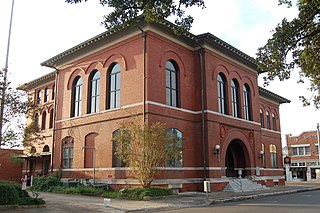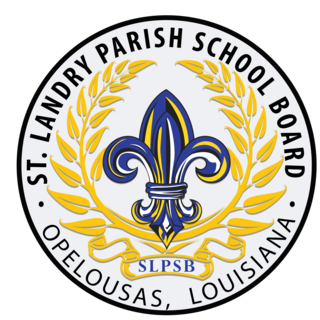
St. Landry Parish is a parish located in the U.S. state of Louisiana. As of the 2020 Census, the population was 82,540. The parish seat is Opelousas. The parish was established in 1807.

Beauregard Parish is a parish located in the U.S. state of Louisiana. As of the 2020 census, the population was 36,549. The parish seat and most populous municipality is DeRidder. The parish was formed on January 1, 1913.

Krotz Springs is a town in St. Landry Parish, Louisiana, United States, on the Atchafalaya River. The population was 1,198 at the 2010 census, down from 1,219 in 2000. It is part of the Opelousas–Eunice Micropolitan Statistical Area.

Opelousas is a small city and the parish seat of St. Landry Parish, Louisiana, United States. Interstate 49 and U.S. Route 190 were constructed with a junction here. According to the 2020 census, Opelousas has a population of 15,786, a 6.53 percent decline since the 2010 census, which had recorded a population of 16,634. Opelousas is the principal city for the Opelousas-Eunice Micropolitan Statistical Area, which had an estimated population of 80,808 in 2020. Opelousas is also the fourth largest city in the Lafayette-Acadiana Combined Statistical Area, which has a population of 537,947.

Washington is a village in St. Landry Parish, Louisiana, United States. The population was 742 at the 2020 census. It is part of the Opelousas–Eunice Micropolitan Statistical Area. Washington was the largest inland port between New Orleans and St. Louis for much of the 19th century.
Opelousas Catholic School is a private, Catholic school in Opelousas, Louisiana. Located in the Roman Catholic Diocese of Lafayette, the school offers education from pre-kindergarten 3/4 through 12th grade.

Courthouse Place, also known as the former Cook County Criminal Court Building, is a Richardsonian Romanesque-style building at 54 West Hubbard Street in the Near North Side of Chicago. Now a commercial office building, it originally served as a noted courthouse. Designed by architect Otto H. Matz and completed in 1892 or 1893, it replaced and reused material from the earlier 1874 criminal courthouse at this site. The complex included, in addition to the successive courthouses, the cell blocks of the Cook County Jail, and a hanging gallows for prisoners sentenced to death. During the 1920s the attached jail housed almost twice its intended capacity of 1,200 inmates, and a shortage of court rooms led to a backlog of cases.

Ray's Ferry in Louisiana, United States, is the point along Bayou Boeuf in Avoyelles Parish, at which the road between Opelousas and Marksville crossed the waterway. A ferry service operated here from 1816. It is unknown how long the ferry was in service. The name comes from the individual, Reuben Ray, licensed to operate the ferry service. Ray was granted a permit from the State of Louisiana on September 19, 1816, to "keep a ferry across the Bayou Boeuf on the main road leading from Opelousas to Avoyelles". The permit can be inspected at the Court Archives of Saint Landry Parish, Courthouse, Opelousas, LA.

The St. Landry Parish School Board is located in Opelousas, Louisiana. The St. Landry Parish School District is rated a C district. Mr. Milton Batiste, III is the superintendent of the St. Landry Parish School System.

St. Landry Catholic Church is a historic Roman Catholic church in Opelousas, Louisiana. It is dedicated to Saint Landry of Paris. The current church building, in Gothic and Romanesque Revival style, was completed in 1909. The church and cemetery were placed on the National Register of Historic Places in the United States on May 5, 1982. By 1792, the church had been renamed from the original title, "Parish Church of the Immaculate Conception of the Post of Opelousas".

This is a list of the National Register of Historic Places listings in St. Landry Parish, Louisiana.
Magnet Academy for Cultural Arts (MACA) is a public magnet high school, with focus on cultural arts, located at 1100 E. Leo Street in Opelousas, Louisiana, United States.
The Opelousas massacre, which began on September 28, 1868, was one of the bloodiest massacres of the Reconstruction era in the United States. In the aftermath of the ratification of Louisiana's Constitution of 1868 and the Fourteenth Amendment to the United States Constitution, tensions between white Democrats and Black Republicans in St. Landry Parish, Louisiana escalated throughout the summer of 1868. On September 28, white schoolteacher and Republican newspaper editor Emerson Bentley was attacked and beaten by three, Democratic white supremacists while teaching a classroom of Black children in Opelousas, Louisiana. Rumors of Bentley's death, while unfounded, led both Black Republicans and white supremacist Democrats, including the St. Landry Parish chapter of the Knights of the White Camelia, to threaten violent retribution. In the days following Bentley's subsequent covert flight to New Orleans, the massacre began. Heavily outnumbered, Black citizens were chased, captured, shot, murdered, and lynched during the following weeks. While estimates of casualties vary widely, several sources number the deaths between 150 and 300 black people and several dozen whites. Following the massacre, the Republican Party in St. Landry Parish was eliminated for several years.

Plaisance School is a school, established in 1921, in Plaisance, Louisiana, United States. The school was segregated during the Jim Crow-era and served African American students. It also went by the names Plaisance High School, and Plaisance Rosenwald School.
The St. Landry Clarion was a newspaper of St. Landry Parish, Louisiana, established in 1890 in Opelousas, Louisiana, the parish seat. It was started as a four-page weekly. It continued until 1921, when it merged operations with the Star-Progress to form the Clarion-Progress. The newspaper's motto was "Here shall the press the people’s rights maintain, unawed by influence and unbribed by gain." It affiliated with the Democratic Party.
Opelousas Senior High School is a public secondary school located in Opelousas, Louisiana. The school serves 840 students in grades 9 to 12 in the St. Landry Parish School district.
Holy Ghost High School (1874–1971) was a private, Black Catholic secondary school founded in Opelousas, Louisiana, in 1874. It was the first Catholic parochial school for Black students in the parish. It also was named St. Joseph’s Academy for Colored, St. Joseph Convent, St. Joseph School, Holy Ghost School, and Holy Ghost Training School.
Grimble Bell School (1830s–1860), was a segregated private school in Washington, Louisiana, United States, for African American students. It was the earliest African American school in the St. Landry Parish, founded in the 1830s, and shut down in 1860 by White vigilantes.
Opelousas Colored School (1919–1953) was a public segregated school for African American students in Opelousas, Louisiana, United States. It was the first public school for Black students in the city. It was known as St. Landry Parish Training School by 1942, and was succeeded by J.S. Clark High School from 1953 to 1970.















